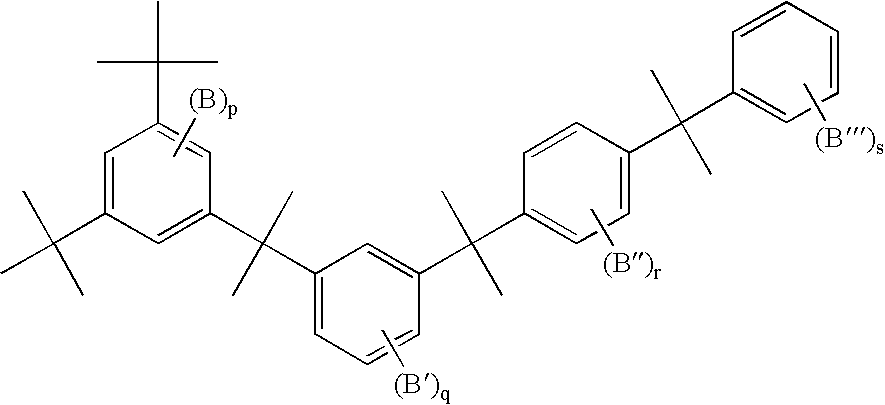Branched polyphenylene polymers
- Summary
- Abstract
- Description
- Claims
- Application Information
AI Technical Summary
Benefits of technology
Problems solved by technology
Method used
Image
Examples
example 1
Activation of Zinc
[0045] Commercially available 325 mesh zinc dust (100 g) was stirred in 100 ml methanol using an overhead stirrer, under nitrogen. A solution of 2 ml conc. HCl in 18 ml methanol was added slowly over about 20 min until the dull gray color of the suspended zinc began to brighten. The mixture was then filtered on a glass frit filter and dried under a stream of nitrogen. The activated zinc powder should be sieved before use to remove any lumps.
example 2
Poly(1,4-(benzoylphenylene)0.92-co-1,3,5-phenylene0.4-co-phenylene0.4)
[0046] A 100 ml round bottom flask was loaded with bis-triphenylphosphine nickel dichloride (0.593 g, 0.906 mmol), triphenylphosphine (3.21 g, 14.04 mmol), activated zinc dust (3.00 g, 45.92 mmol), sodium iodide (0.73 g, 4.86 mmol) and N-methylpyrrolidinone (NMP) (45.33 ml) in an inert atmosphere box. The flask was closed and brought out of the inert atmosphere box. While maintaining the flask under an inert atmosphere, monomers were added in the following amounts: 8.09 g (32.2 mmol) of 2,5-dichlorobenzophenone, 0.254 g (1.4 mmol) of 1,3,5-trichlorobenzene, and 0.158 g (1.4 mmol) of chlorobenzene. The mixture exothermed and cooling was applied to keep the temperature below 92° C. The mixture became viscous in about 10 min. When the exotherm subsided the flask was heated to 65° C. with stirring for 2 hr. The mixture was cooled to room temperature, stirred with ethanolic HCl, and washed with hot ethanol and then ho...
examples 3-14
[0047] The following compositions were prepared using the same general procedure as in Example 2, where monomer D1 is 1,3-dichlorobenzene, monomer D3 is 1,4-dichlorobenzene, monomer D4 is 2,5-dichlorobenzophenone, monomer P1 is 1,3,5-trichlorobenzene, and monomer M1 is chlorobenzene. Solubility was tested in hot NMP. The values in columns 2 through 6 of the table indicate the mole percent of the particular monomer added to the reaction flask. The total amount of monomer was kept nearly constant while the relative monomer amounts were varied.
Ex.D1D3D4P1M1Comments3964Insoluble49055Soluble, melts, MW 75,3865603055Insoluble6801010Soluble, melts, MW 71,4697701515Soluble, MW 237,599 polymodal PDI 2989055Soluble, melts, MW 5,5749502525Soluble, MW 371,154, brittle film10303535Insoluble1110303030Insoluble, appears to melt12204040Insoluble13104545Insoluble1480812Soluble, MW 85, 162
PUM
| Property | Measurement | Unit |
|---|---|---|
| Dielectric polarization enthalpy | aaaaa | aaaaa |
| Composition | aaaaa | aaaaa |
| Moldable | aaaaa | aaaaa |
Abstract
Description
Claims
Application Information
 Login to View More
Login to View More - R&D
- Intellectual Property
- Life Sciences
- Materials
- Tech Scout
- Unparalleled Data Quality
- Higher Quality Content
- 60% Fewer Hallucinations
Browse by: Latest US Patents, China's latest patents, Technical Efficacy Thesaurus, Application Domain, Technology Topic, Popular Technical Reports.
© 2025 PatSnap. All rights reserved.Legal|Privacy policy|Modern Slavery Act Transparency Statement|Sitemap|About US| Contact US: help@patsnap.com



